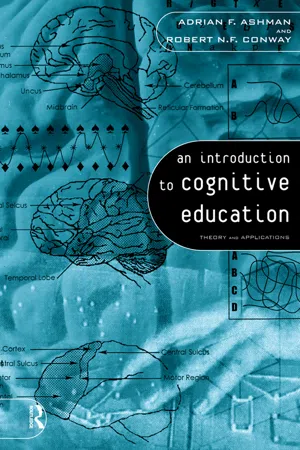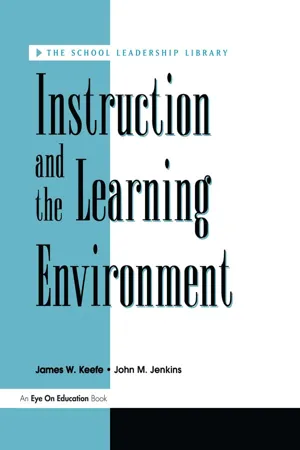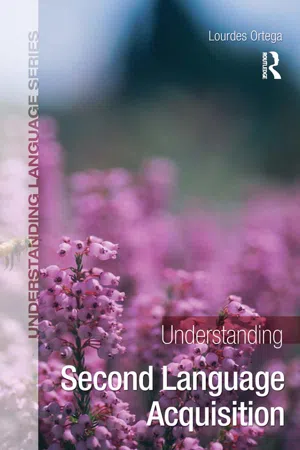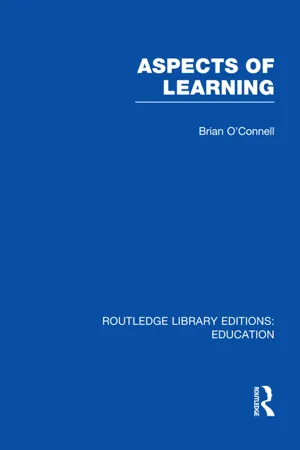Cognition and Learning
Cognition refers to the mental processes involved in acquiring, processing, and using knowledge, including perception, memory, and problem-solving. Learning involves the acquisition of new knowledge or skills through experience, study, or instruction. Both cognition and learning are central topics in psychology, as they are fundamental to understanding how individuals perceive, process, and retain information.
6 Key excerpts on "Cognition and Learning"
- eBook - ePub
An Introduction to Cognitive Education
Theory and Applications
- Adrian Ashman, Robert Conway(Authors)
- 2002(Publication Date)
- Routledge(Publisher)
...Early behaviourists held the view that the environment controlled learning. Later, cognitive-behaviourists introduced the notion that the organism (the human) plays an important role in effective learning and problem-solving. Concurrently, a second tradition in the discipline of psychology was growing. Studies of memory in animals and humans laid the foundation for investigations into the complex thought processes that occur within the brain. Researchers soon began to develop models of memory and thinking based upon their observation and inferences about the link between brain functions and behaviour, which became the field called cognitive psychology. In Chapter 3 we continue with a discussion of the building blocks of cognition. We describe some of the basic concepts, discuss how successful research has been in explaining thinking, learning, and learning processes, and examine the relationship between intelligence and information processing. Box 2.2 A list of common memory terms and their meaning Memory The ability to relive past experience through learning, retention, recall and recognition. Memory trace A hypothetical neurological change that occurs when information is learned and accounts for the retention of this learned material (also called an engram). Short-term memory (STM) The reproduction, recognition, or recall of a limited amount of material up to about 10 seconds. It is characterised by only a limited amount of information being stored at any one time, and there is rapid decay as storage is easily disrupted. Long-term memory (LTM) The ability to practise a skill, recall an event, or reproduce information long after the original learning...
- Claire Valentin(Author)
- 2017(Publication Date)
- CIPD - Kogan Page(Publisher)
...Individual learning is viewed from behaviourist and cognitive theories. Behaviourist learning theories focus on observed behaviour, whereas cognitive theories focus on seeking to understand the mental processes of thinking and learning. An understanding of different types and processes of learning is important in designing L&D interventions to enhance engagement in learning. Behaviourism: classical and instrumental conditioning In behaviourism, the concepts of classical and operant conditioning inform approaches to learning. QUESTION Think of examples in your work or personal life where behaviourist principles influence learning. Cognitive perspectives: memory and information processing Whereas the behaviourist approach focuses on observed behaviour, the cognitive perspective on learning focuses on understanding internal mental process, interpreting how external information is encoded, stored in, and retrieved from memory. In reading this text, for example, how does your brain make sense of it? Encoding includes processes of perception and interpretation of external stimuli, and the transfer into cognitive representations. You perceive the text through your visual senses (via your eyes). You interpret the images (the letters, which make up words and sentences) and create your own cognitive representations, or knowledge, in the form of schemata and scripts. Schemata are cognitive frameworks representing the structure of objects or concepts. The schema ‘house’, for example, comprises the knowledge that a house is a kind of building, that the discreet parts are ‘rooms’, that it is built of wood or stone, that it serves as a dwelling, that it consists of right angles, and so forth. Scripts are a special kind of schemata...
- eBook - ePub
- James Keefe, John Jenkins(Authors)
- 2013(Publication Date)
- Routledge(Publisher)
...“The new technology made new psychological theories possible—theories that are much more complex and interesting than S-R theories. Because of the computer, we can finally unpack the hyphen. We can spread on the table all sorts of marvelous ideas about the stream of mental processes that are activated by a stimulus and that generate the response. And we can at last get on with the important business of investigating the conditions that expedite cognition—the conditions of good instruction.” (Farnham-Diggory, 1992, p. 46). Computer paradigms enabled psychologists to construct new simulations of mental processes and to overturn the crudest forms of behaviorism. Howard Gardner (1985) aptly summarizes the work of the cognitivists in The Mind's New Science. Cognitive science is based on the belief that information can be mentally represented, manipulated, and studied. (Behaviorism alleged exactly the opposite.) This new science is interdisciplinary, rooted in philosophy, and uses the computer as its basic tool. It proposes a new structure or architecture of thinking and learning. I NFORMATION P ROCESSING T HEORY Cognitive psychology is concerned with information processing—what human beings do when they think and learn. Differences of opinion do exist about the exact structures of the mind, what computer scientists call its “system architecture,” but general agreement exists on three basic structures: (a) Perceptual Systems (also called Information or Start-Up Systems), (b) Short-Term or Working Memory, and (c) Long-Term Memory (see Fig. 2.1) F IGURE 2.1. T HE H UMAN I NFORMATION P ROCESSING S YSTEM P ERCEPTUAL S YSTEMS Information coming from the actual world is held briefly in perceptual or trace memories (sometimes called buffers). During the ¼ to 4 or 5 seconds of trace memory, the working memory decides whether the information is important and whether to reject, memorize, transform, or learn it. For example, a person sees a picture or hears a sound...
- eBook - ePub
- Lourdes Ortega(Author)
- 2014(Publication Date)
- Routledge(Publisher)
...5 Cognition Cognition refers to how information is processed and learned by the human mind (the term comes from the Latin verb cognoscere, ‘to get to know’). SLA researchers interested in cognition study what it takes to ‘get to know’ an additional language well enough to use it fluently in comprehension and production. We are far from a satisfactory understanding of second language as a form of cognition, however. This is because our capacities to investigate the relevant questions are shaped by the pace at which new theories and methods to inspect the workings of human minds and brains become available (typically in neighbouring disciplines) and the rate at which SLA researchers become conversant in them. In this chapter, more than in any other, I will make frequent reference to relevant L1 research and point at areas where future attention by SLA researchers will be needed. It is also important to realize that, in cognitive research, the relevant behavioural and neurobiological evidence falls in the order of a few hundred milliseconds to a few seconds, or it consists of larger-scope performance that nevertheless lasts a few minutes to a few hours at the most. This is in sharp contrast with many of the data on language learning SLA researchers normally consider, which involve stretches of discourse, multi-turn interactions with human interlocutors, extended texts, referential and social meaning, and even years of studying, using or living with an L2. Thus, the differences in grain size, temporal and ontological, of the various phenomena that are brought together into cognitive explorations of L2 learning are puzzling. In this chapter you will learn about cognitive SLA theories and constructs that have been developed to explain the nature of second language as a form of cognition...
- eBook - ePub
Understanding How We Learn
A Visual Guide
- Yana Weinstein, Megan Sumeracki, Oliver Caviglioli(Authors)
- 2018(Publication Date)
- Routledge(Publisher)
...Part 2 Basics of Human Cognitive Processes 5 Perception 6 Attention 7 Memory 5 Perception Perception Information is interpreted differently depending on the context and the person – there are no absolutes. As teachers, we need to be sensitive to these differences, which sometimes means taking another’s perspectives. Before we can talk about learning, we have to talk about perception. This is because perception determines how we understand the world. Perception allows us to make sense of the world. Although we will focus on vision and hearing in this chapter, because they are arguably most relevant to learning in an academic context, we should emphasize that perception involves all five of our senses: vision, hearing, touch, taste, and smell. Let’s start with an example from hearing. Imagine you are alone, hiking in a forest. All of a sudden, you hear a loud cracking noise. How do you react? Do you think it’s a branch and keep walking? Do you think it’s a gunshot and get scared? Do you think it’s a gun shot and not get scared, because you know that there are hunters nearby and you’ve taken the right precautions to avoid the designated hunting area? If you thought it was a branch, you probably didn’t have much of a reaction. But if you thought it was a gunshot, your heart rate might have risen, more or less depending on your familiarity with the layout of the forest (Goldstein, 2009). This example illustrates that the way we interpret something (in this case, a sound) depends on what we know about it. But knowing that the crack is a cracking branch rather than a gunshot doesn’t literally change the sound waves – it only changes the way you hear them. This is the key to the difference between sensation and perception. Sensation is the signals received by your organs through the five senses, whereas perception is the interpretation of those signals...
- eBook - ePub
- Brian O'Connell(Author)
- 2012(Publication Date)
- Routledge(Publisher)
...Chapter 5 Physiological Processes Involved in Learning Up to the present we have concerned ourselves with external processes in learning which are visible to the teacher and observer, but there are also vital internal processes taking place which are not directly observable. These activities occur in the central nervous system (CNS), consisting of the brain and spinal cord, and the success of all learning is largely dependent upon the activity of this part of the human organism. For a child to learn, whatever the method or learning situation, three activities must take place: 1. The organism (the child) must seek out and take in information from the outside world or environment, known as the stimulus (S). 2. The organism (the child) must make some response (R). 3. The organism (the child) must be able to alter, if necessary, the relationship between the information coming in (S) and the response (R). How does the brain acquire its information? At the physiological level it must do so through the sensory organs, namely, the eyes, ears, nose, tongue and by touch. In Fig. 19 it will be seen that the information arrives at the various reception organs in different forms of energy; and in the teaching situation the most important sources of information are those of vision, hearing and touch. When teaching we do not rely so much on taste and smell, apart from such specialist areas as domestic science. Figure 19 As teachers we impart most of our information so as to reach the child through his ears, eyes and surface reception, or touch. This information arrives at the body in different forms and has to be translated into a common language or code so that the brain can deal with it as quickly, efficiently and accurately as possible. Not only is this so but, paradoxically, a major portion of it has to be discarded or rejected...





